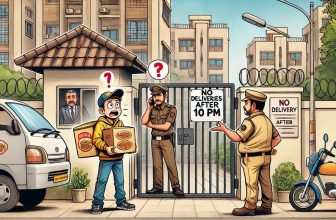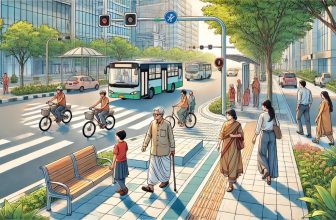India is a land of vibrant culture, rich traditions, and rapid modernization. But with this diversity comes a set of challenges that are uniquely Indian—problems that might seem odd to outsiders but are a part of daily life for millions. While we have mastered the art of jugaad (quick fixes), some of these problems deserve real, long-term solutions.
Here are 10 weirdly specific Indian problems that need innovative and practical solutions.
1. Monkey Menace in Cities – When Monkeys Rule the Streets
In cities like Delhi, Jaipur, and Varanasi, monkey gangs freely roam the streets, snatching food, invading homes, and sometimes even attacking people. Many temples and tourist spots have become hotspots for aggressive monkeys who have adapted to urban life.
Potential Solution:
Creating dedicated monkey sanctuaries on the outskirts of cities, along with a controlled feeding program, can help reduce human-monkey conflicts. Implementing sterilization programs, as seen in some wildlife conservation projects, can also manage their growing population.
2. The Great Indian Spitting Epidemic – When Roads Become Red Carpets
Pan masala and gutka chewers love decorating walls and roads with red stains, turning public spaces into unhygienic messes. Even newly painted walls get targeted within days!
Potential Solution:
Installing designated public spittoons in high-traffic areas with strict fines for violators can help curb this habit. Campaigns like “No Spit Zones” in Mumbai have shown success and can be expanded nationwide.
3. Wedding Food Wastage – The Grand Indian Buffet Disaster
Indian weddings are all about lavish buffets with 100+ dishes, but a shocking amount of food goes to waste. Guests pile their plates high, only to leave half-eaten delicacies behind.
Potential Solution:
Mandating food waste monitoring at wedding venues and partnering with food rescue organizations like Feeding India can ensure excess food is distributed to those in need. Some cities are already implementing strict food waste policies—time to make it a national practice!
4. The Public Toilet Crisis – Finding a Clean Washroom Is a Treasure Hunt
Public restrooms in India are often unusable—dirty, smelly, and lacking water or soap. Many people, especially women, avoid using them altogether, leading to health issues.
Potential Solution:
A rating system for public restrooms, similar to Swachh Bharat’s initiative, can encourage better maintenance. Tech-based solutions like Google Maps integrating real-time cleanliness ratings (similar to restaurants) can also help people locate hygienic restrooms.
5. Overcrowded Railway Platforms – The Ultimate Survival Challenge
Indian railway stations, especially during peak hours, resemble chaotic battlefields. People push, jump, and sometimes hang onto trains just to get a seat, leading to accidents and delays.
Potential Solution:
Introducing AI-powered crowd control and staggered boarding systems, similar to Japan’s railway network, can regulate passenger flow. Encouraging app-based seat reservations for general compartments can also reduce last-minute rushes.
6. The Struggle of Living in a Joint Family – Privacy? What’s That?
Many Indian families still live in joint households where privacy is a myth. Personal space is practically non-existent, and every decision—from marriage to dinner menus—is a family affair.
Potential Solution:
Architects and real estate developers can design modular homes that allow extended families to live together while ensuring privacy. Smart home technology can also help divide spaces dynamically based on needs.
7. The Never-Ending Wedding Season – When Every Weekend Is Booked
Indian weddings aren’t just one-day events—they stretch for weeks, causing traffic jams, noise pollution, and venue shortages. Families often struggle to book banquet halls and vendors, especially in peak season.
Potential Solution:
Implementing a wedding calendar system where families register their wedding dates in advance can help cities regulate event planning. Incentives for off-season weddings can also reduce the rush.
8. The Unwritten Rule of Dowry – Still a Reality Despite Laws
Even though dowry is illegal, many families still consider it a “tradition.” The pressure to give or receive dowry persists, often leading to financial strain or even abuse.
Potential Solution:
Strict enforcement of anti-dowry laws, along with anonymous reporting systems, can help curb this practice. Public awareness campaigns that celebrate dowry-free marriages can also bring societal change.
9. The Never-Ending Horoscope Matching Drama – Stars vs. Common Sense
Many Indian families still rely on horoscope matching for arranged marriages, sometimes rejecting perfectly good matches over minor astrological mismatches.
Potential Solution:
Introducing scientifically-backed compatibility tests alongside traditional horoscope matching can offer a balanced approach. Families should also be educated on how personality and values matter more than star alignments.
10. The Engineering or Medical Career Dilemma – Every Parent’s Dream, Not Every Student’s
In India, choosing a career outside engineering, medicine, or government jobs is often seen as risky. Many students end up in professions they don’t love, just to meet family expectations.
Potential Solution:
Introducing mandatory career counseling in schools that expose students to diverse career paths—from design to sports analytics, can help them make informed decisions. Encouraging internships and mentorship programs can also provide real-world exposure to different industries.
Conclusion – Turning Unique Problems into Unique Solutions
India’s diversity brings challenges that are both frustrating and fascinating. While jugaad helps in the short term, real change comes from structured innovation and community-driven solutions. Whether it’s tackling monkey invasions, fixing overcrowded railways, or redefining traditional beliefs, these uniquely Indian problems deserve smart, localized solutions that blend practicality with cultural sensitivity.





